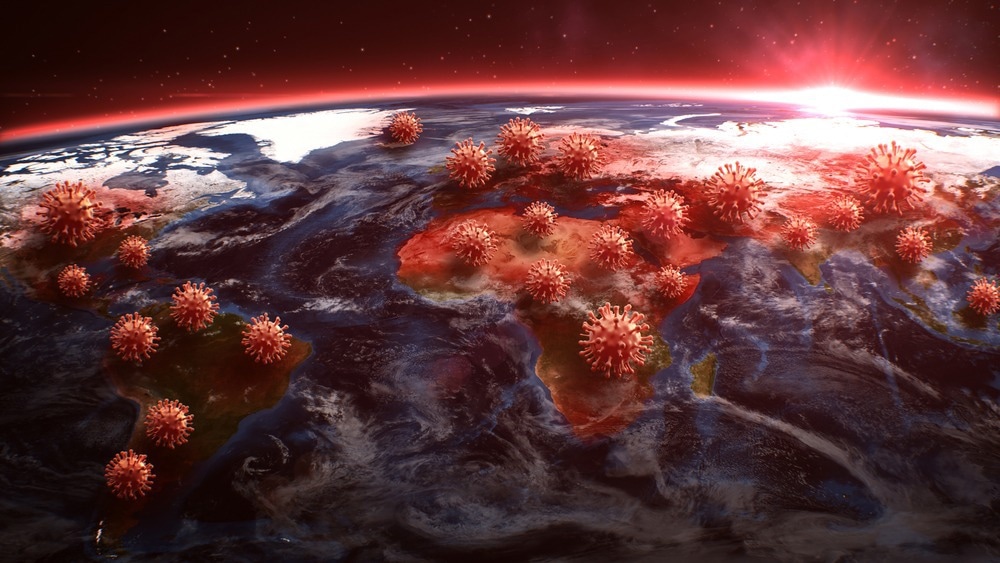In a recent study posted to the medRxiv* preprint server, researchers assessed the dispersion patterns of severe acute respiratory syndrome coronavirus 2 (SARS-CoV-2) variants and their global expansion.
 Study: Global Expansion of SARS-CoV-2 Variants of Concern: Dispersal Patterns and Influence of Air Travel. Image Credit: RCW.studio/Shutterstock
Study: Global Expansion of SARS-CoV-2 Variants of Concern: Dispersal Patterns and Influence of Air Travel. Image Credit: RCW.studio/Shutterstock

 *Important notice: medRxiv publishes preliminary scientific reports that are not peer-reviewed and, therefore, should not be regarded as conclusive, guide clinical practice/health-related behavior, or treated as established information.
*Important notice: medRxiv publishes preliminary scientific reports that are not peer-reviewed and, therefore, should not be regarded as conclusive, guide clinical practice/health-related behavior, or treated as established information.
Background
After the global vaccination introduction, travel restrictions as well as other public health and social measures (PHSM), have been gradually lifted in the majority of the world, restoring travel and mobility trends to pre-pandemic levels. Despite the severity and breadth of travel restrictions, various SARS-CoV-2 strains have spread to and gained popularity worldwide.
Understanding the global dissemination patterns of SARS-CoV-2 variants of concern (VOCs) with respect to global and local human movement is essential to objectively assess the relative significance of targeted travel restrictions for pandemic prevention.
About the study
In the present study, researchers employed phylogeographic and phylogenetic techniques to reconstruct the global distribution trends of SARS-CoV-2 VOCs.
To quantify the worldwide distribution patterns of each SARS-CoV-2 VOC, the team reconstructed the ancestral state of discrete spatial locations utilizing dated phylogenetic trees derived from a sample of representative sampled genomes. A sampling of genomes was performed proportionally to the nation and variant-specific infection counts, and tests were repeated on ten replicates of approximately 20,000 sample genomes per VOC. Evaluating the net difference among importation events and viral exportation for each nation and continent indicated the continental source-sink dynamics.
To investigate how air travel has affected the speed of VOC dispersion globally, the team analyzed the volumes of global air travel passengers from February 2020 to March 2022 before comparing them to the VOC dispersion speed in countries that reported VOCs using genetic information. This delay was measured as the number of days observed between the time to the most recent common ancestors (TMRCAs) corresponding to each VOC from published research and the date on which the first VOC sequenced sample was collected in each nation.
To examine the correlation between worldwide air travel and the latency in global VOC dispersal, the team estimated pairwise correlations between sampling postponements for each nation for each VOC and the total incoming travel volumes for that country during VOC dispersal, as well as the incoming travel volumes from the presumed origin countries corresponding to each VOC.
Results
The study results demonstrated that each VOC has separate global expansion patterns. From November 2020 to December 2020, through June 2021 to July 2021, the SARS-CoV-2 Alpha, Beta, and Gamma variants showed global co-circulation. The United Kingdom (UK) contributed the highest calculated number of exports globally. The team noted that global expansion could be regarded as a multi-stage process. Towards the end of 2020 and the start of 2021, the team expected Alpha to have spread primarily in Europe and then from Europe to Asia and the Americas.
Most Alpha introductions to Africa originated in North America or Europe, first to West Africa and further to East Africa. Also, from February 2021 to May 2021, the Alpha variant spread throughout Asia and the Americas, and viral lineage exchanges from East Africa to Asia were seen.
Approximately 50% of southern Africa's Beta exports were to areas within the same region. In addition, the researchers inferred significant Beta diffusion to Western Europe from southern Africa and then within Western Europe itself. Africa and Asia were inferred to be a net source of Beta, with exports peaking post-April 2021.
Due to their genetic differences, the distribution trends of Omicron lineages BA.1 and BA.2 were identified separately until March 2022. Consistent with the first significant Omicron BA.1 wave in southern Africa, the earliest BA.1 exportation events were inferred to have occurred in southern Africa between November and December 2021, generating a massive infection wave from December 2020 to March 2021. Thereafter, most Gamma variants were transported to other South American nations.
After their emergence, the Alpha, Beta, and Gamma variants were initially sampled for sequencing in nations with a delay of approximately 64 to 425, 95 to 300, and 48 to 251 days, respectively. On average, countries needed almost 45 to 336 days longer to sequence the Delta variant after its predicted emergence in October 2020.
With the exception of Beta, the team found negative and considerable associations between total travel numbers and delays to first VOC sampling in nations worldwide, confirming the expected relationship between larger travel volumes and reduced VOC arrival delays. Furthermore, a strong negative association was noted between the travel volumes and delays from the countries that initially noted the respective VOCs, suggesting that VOCs appear in a nation having less delay if that country receives a large number of travelers from the presumed origin country of that VOC.
Conclusion
Overall, study findings demonstrated that SARS-CoV-2 VOCs diffused globally according to distinct source-sink dynamics. The study also noted that, in general, global travel hubs significantly contributed to viral exportations.

 *Important notice: medRxiv publishes preliminary scientific reports that are not peer-reviewed and, therefore, should not be regarded as conclusive, guide clinical practice/health-related behavior, or treated as established information.
*Important notice: medRxiv publishes preliminary scientific reports that are not peer-reviewed and, therefore, should not be regarded as conclusive, guide clinical practice/health-related behavior, or treated as established information.